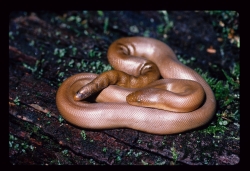
showing tail scarred by rodent bites
Courtesy & Copyright,
Edmund ‘Butch’ Brodie, Photographer
 Rubber boa Charina bottae
Rubber boa Charina bottae
showing small head
Courtesy & Copyright ©
Andrew Durso, Photographer
 Rubber boa Charina bottae
Rubber boa Charina bottae
showing blunt tail
Courtesy & Copyright ©
Andrew Durso, Photographer
Mention boas and we imagine steaming South American rain forests, home to emerald tree boas and enormous boa constrictors. However, the canyons of northern Utah are home to the rubber boa, one of only two native North American boas. Rubber boas range from northern Utah west to the Pacific coast and north to Vancouver. An adult rubber boa resembles a thin kielbasa sausage in size and shape, having both a blunt tail and head. Juveniles are the size of a crayon. A rubber boa’s leathery skin is the color of creamy coffee, its small scales giving it a rubbery texture. Like other boas, it has vestigial hind legs, called spurs, with which males stimulate females during mating.
Rubber boas are active at night during the summer. In spring they can be among the first snakes to come out from the talus slopes and rock crevices where they hibernate. In Cache County, rubber boas can be found basking from March through November. From April to August, pregnant females use these rocky habitats to maintain body temperatures around 88 degrees. When not pregnant, rubber boas stay remarkably cool for a snake, around 57 degrees. In late summer, females bear an average of four live young. They only reproduce every two to three years, so juvenile survival must be quite high. In captivity, rubber boas can live 30 years or more.
It’s hard to imagine these docile, slow-moving snakes as predators, but rubber boas eat mammals, birds, reptiles and eggs. Like other boas, they have no venom and kill by constriction. Rubber boas often consume whole litters of nestling mice, voles, pocket gophers, shrew and moles. The snakes fend off the protective rodent parents with their short, blunt tails, which often bear bite scars. Both rubber boas and rodents evolved in Asia about 45 million years ago which suggests that they have been predator and prey for a very long time.
Thanks to Andrew Durso, Utah State University herpetology student, for today’s essay.
This is Linda Kervin for Bridgerland Audubon Society.
Credits:
Images: Courtesy and Copyright Andrew Durso and Edmund ‘Butch’ Brodie
Text: Andrew Durso, Utah State University herpetology doctoral candidate, https://www.biology.usu.edu/htm/our-people/graduate-students?memberID=6753
Additional Reading:
Life is Short, but Snakes are Long: https://snakesarelong.blogspot.com/2012/04/utahs-boa.html
Utah Division of Wildlife Resources: https://dwrcdc.nr.utah.gov/rsgis2/search/Display.asp?FlNm=charbott
Cox DT & WW Tanner (1995) Snakes of Utah. Bean Life Science Museum, Provo, UT https://www.amazon.com/Snakes-Utah-Douglas-C-Cox/dp/0842523316
Ernst CH & EM Ernst (2003) Snakes of the United States and Canada. Smithsonian Institution Press, Washington D.C. https://www.amazon.com/Snakes-United-States-Canada-Ernst/dp/1588340198
